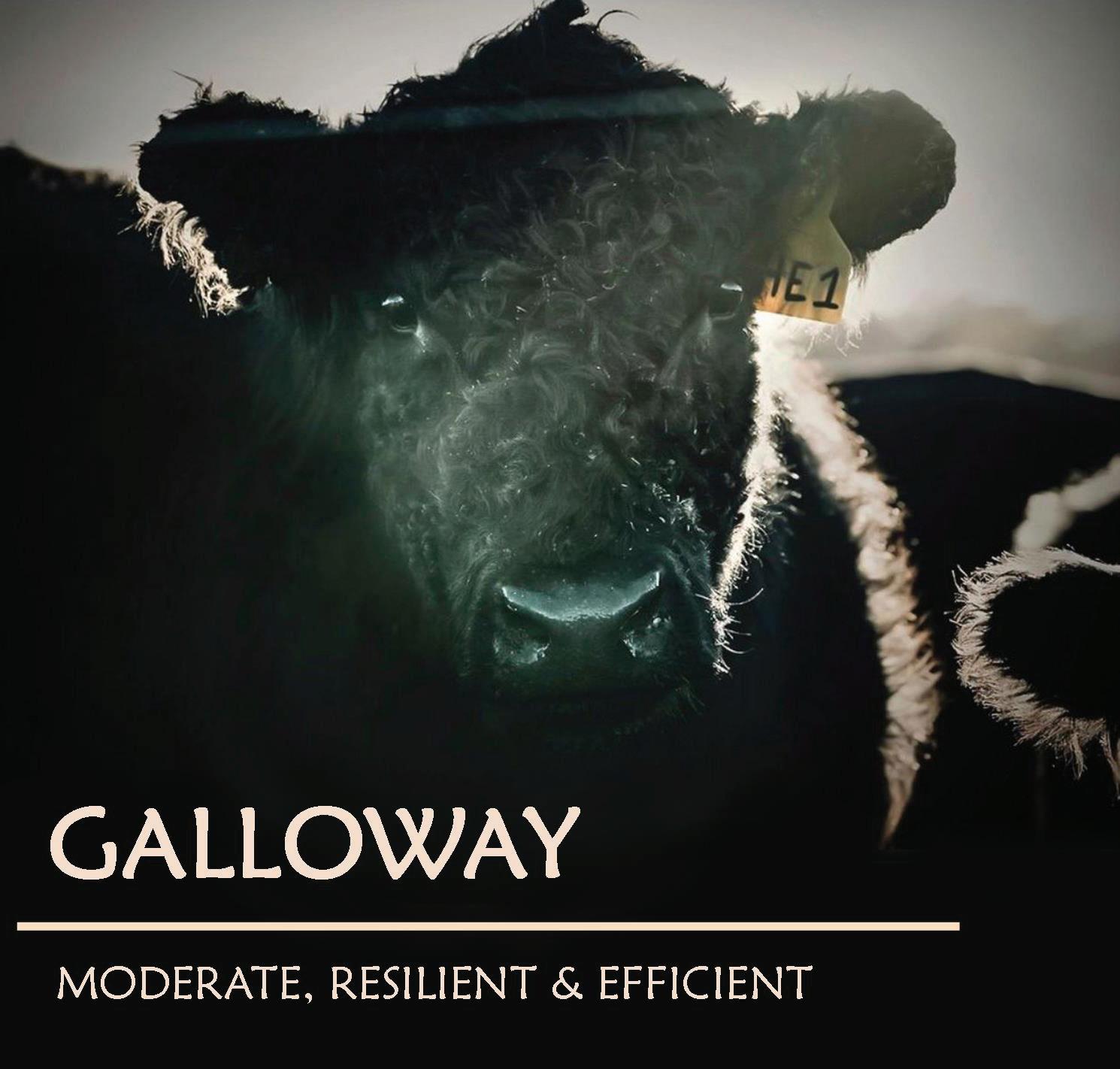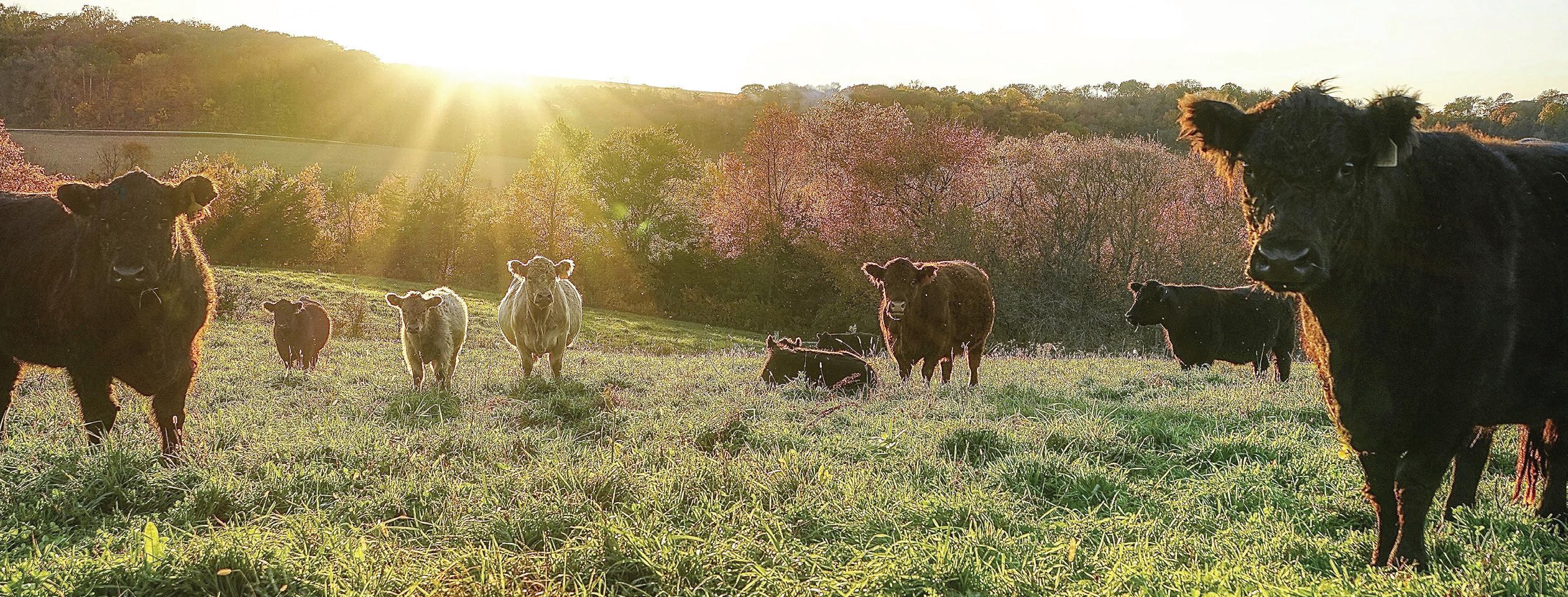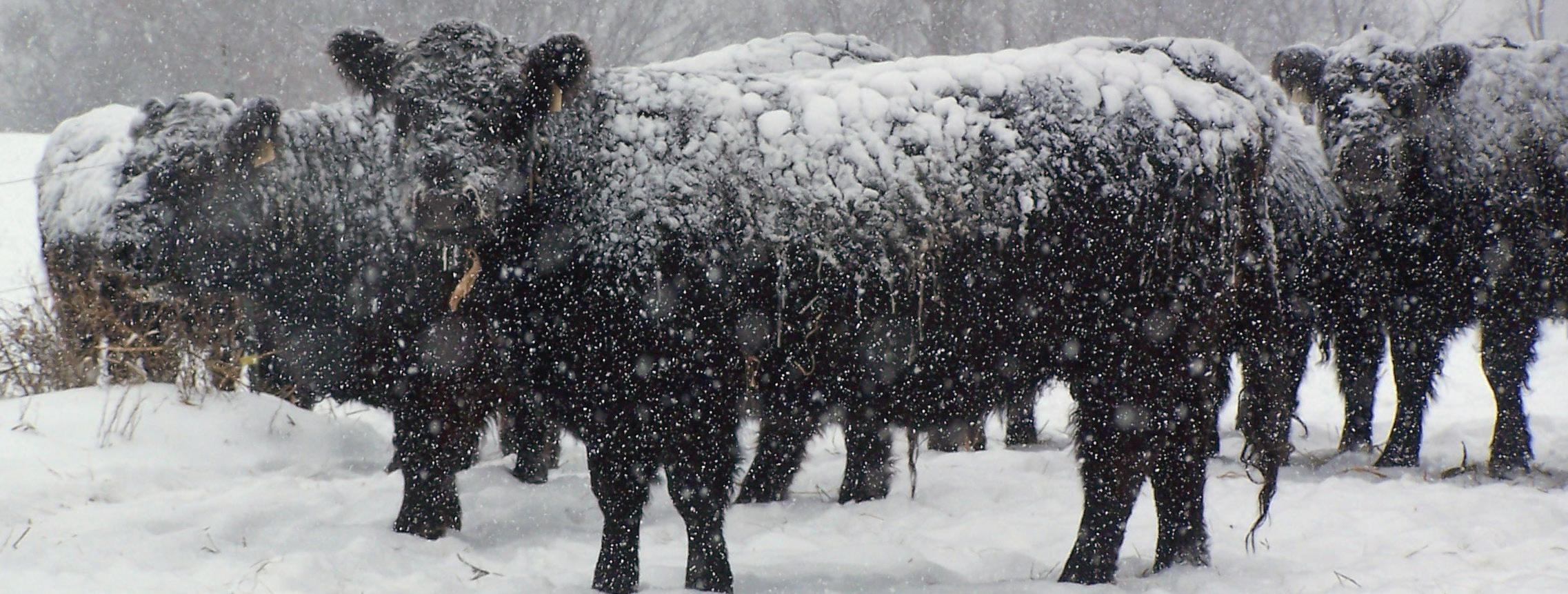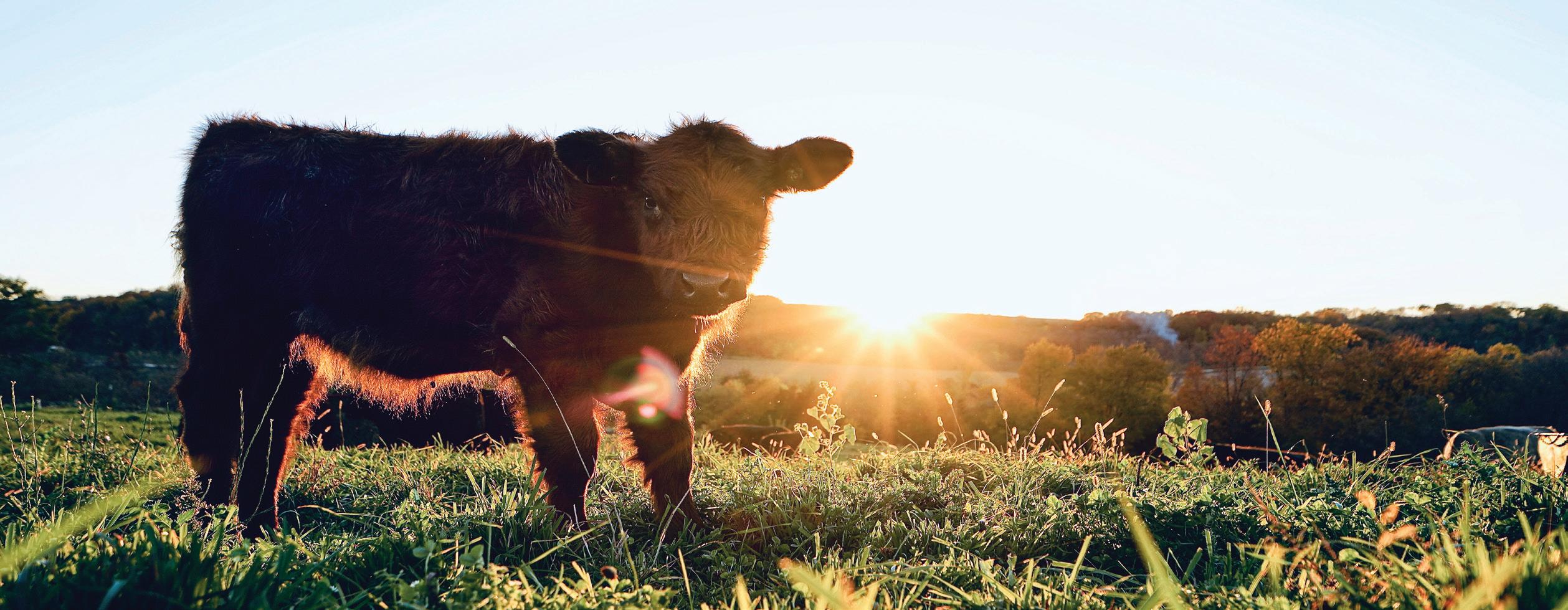
9 minute read
GALLOWAY

photo courtesy of DerekSamplePhotography.com
by Leslea Hodgson, Root Prairie Galloways & American Galloway Breeders Association
Why did we go with Galloways?
They are easy keepers. With so much emphasis placed on feed efficiency in a cow, we are confident we chose the right breed. Feed efficiency is not their only attribute but a good place to start. We use the breed in a grass only management system, and can only speak about what we are doing, which is cow-calf to finish, and most of the time selling our beef direct to the consumer. We do a spring-summer calving season and try to keep it timed with the availability of grass in our pastures. If we are timing it right we are finding whitetail fawns hidden in the grass while we are checking for calves. When our young calves are growing they are doing it on the rich milk of a Galloway cow and the best pastures and hay we can offer to them. No creep in our pastures, while purchasing inputs to augment the available forages is an option to better balance the diet, it is added expense. So given how well they do in our system we rarely buy supplements.
How did you get started?
After having finally found the farm we would call ‘home’ it wasn’t all green grass and high times, it was chisel plowed corn fields and bean fields on hills with washes and areas with not a lot of topsoil. We had a whole lot of work ahead of us and it was down to finding the right cattle to use in the reclamation process of returning corn fields to thriving, diverse pastures. We employed the advice of an old timer up north who had seen plenty of cows and winters, Brad’s grandfather Nile. Nile had for decades raised the traditional black baldy in north central Minnesota and when we asked him what would he do if he was just starting out he answered: “I would get Galloways... they are said to be easy keepers”.
We were lucky to have had the opportunity early on to attend a two week workshop focused on grazing management and taught by the late Terry Gompert, Center, NE. in which we were introduced to mob grazing, and beyond that the concept of building soil by intentionally trampling forages while grazing. Grazing in ways that can put one at odds with some so-called experts, we utilize our pastures with multiple purposes in mind, the needs of the cattle, the needs of the soil and it’s microorganisms, the plants and wildlife, and especially the grassland birds. Because our Galloways do well with mature forages we are able to use them in tall midsummer paddocks that may not have been grazed in the spring to do that trampling without compromising breeding performance. In early July of each summer they spend a couple of weeks on a Big Bluestem pasture where they can graze soft tall grass for a while and get away from the flies, the protein is lower but they do very well on it.
“Man, Cattle and Veld” by Johann Zeitsman

Galloways go back at least 450 years!
The ancient genetics under a Galloway cow‘s hide have traveled the corridors of time in a journey that can be traced from the U.S. ranch where she was born back up through Canada, across the pond and finally to the southwestern hills of Scotland where her breed evolved. Today she fulfills her genetic calling as she has for nearly 500 years by raising thrifty calves while thriving on forages alone. In the summer months southeastern Minnesota can get extremely humid hitting dew points in the high 80’s and the weather forecast is only good for about 12 hours making quality dry hay production a challenge. In the winter months cows that can make the most of lignified mixed hay are a necessity, not because there is never any other more digestible feedstuffs it’s just that there is a much higher percentage of the season’s first cutting of hay.

The young stock are left on the cows through most of the winter eating hay and getting some milk along with it. While this technique does not get you there fast it does develop a well-functioning rumen. With the practice of weaning late winter around the full moon in February the calves don’t experience much stress, they are well acclimated to the Minnesota winter weather and the days are getting longer, even with many possible storms to come, winter has mostly rounded the corner by then. This herd typically makes it through the seasonal transitions which can be very wet and extremely cold & windy, without the need for medication or veterinary treatment thanks to their double winter hair coat, gut capacity and, lest we forget, the mitochondrial DNA of the hundreds of extremely hardy Galloway cows before them. The Galloway’s double winter hair coat working for the calves protect them from the adverse weather; icy and cold at the outer coat but warm and dry in the down layer at the skin. Reducing cold stress helps the calves stay healthy.

In a study by Montana State University it was demonstrated that additional winter coat thickness makes a difference and can reduce the digestible feed intake requirements for a cow by as much as 25%.
Meat quality at the same time as Low Input Management, This could be a big ask!

photo courtesy of DerekSamplePhotography.com
Beyond the desire for easy keeping low maintenance cattle we also wanted to finish them on grass alone. Considering the limitations on available calories in a low input perennial pasture system on the one hand, and the challenges of balancing a bovine diet on pasture alone with a desire for quality beef on the other the Galloways have performed extremely well. We could start using annuals if we needed to for higher energy forages but that action would disrupt the soil structure and microbial environment, for now the extra tillage required hasn’t been warranted.

The conundrum for us is that the perception from the health conscious customer is: beef as a protein source has too much fat. The marketing claims are that beef is lean, and that the grass fed option has a better type of fat profile but now some grass fed beef is extraordinarily fat. We think we have found the balance point somewhere in the middle for our product with enough intramuscular fat for a delicious eating experience yet not too much heavy visible fat. After a few years of getting to know the cattle and the growth curves of both the cattle and their forages we have been able to turn out a carcass with a moderate cover of fat so there is almost no trimming, with yields in the high 50’s to low 60’s percentiles, and the excellent meat to bone ratio that Galloways are well known for. These are factors that can make a substantial difference if you sell beef. This ability to convert feedstuffs to excellent quality beef and do it efficiently has been demonstrated here and proven through scientific trials at Clay Center, NE & Olds College, Alberta, Canada as well as through the ordinary day to day on farms and ranches across the U.S and Canada.

Smart animals, easy to train, and Galloway Bulls are very easy going!
We picked out 6 bred cows to be delivered after calving and a bull to borrow for the first breeding season. Each cow was a little different, some of the cows were short, some taller, some quieter, one hotter and a couple that would have smoked the dog had they the chance. In the how to books and articles the descriptions of the perfect grass finish cow are plenty. What has happened through the past 20 years of grazing our farm is that some of the “type” that should not have worked have done very well and others maybe that looked the part had a harder time with our management. Striving for the mean, not interested in any extremes has been an underlying part of our direction. Going forward and allowing the farm and it’s available resources to sort, keeping any heifer that appeared to be as good as or better than her dam and using just about any bull we raised that flourished while being raised on hay and grass or out of an older cow who has performed well has created a sturdy herd for our location and management. It hasn’t really been all that tied to conformation as much as it has been about constitution.
The ability of the Galloway female to attain sufficient body condition fo breeding on grass alone is what gives her dependable fertility. She will calve by 24 months of age. She has never been fed any kind of heifer development diet and was on 93 RFV hay most of last winter with the cow herd, on pasture the rest of the time.

Galloways have great Adaptability!
Galloway cattle are flourishing across the USA and its environmental spectrum. From New Mexico to New York, Washington State to Florida, and the Great Plains north to south. Producers are infusing a bit of ‘old school’ into their programs.

photo courtesy of DerekSamplePhotography.com

A young bull growing the way they like to see. His dam has done well for many years raising calves and producing enough butterfat in her milk so that her offspring produce excellent beef. This bull will not be fed any protein other than what is available in the pastures and hay, probably an average of about 14%. He’ll be allowed time to grow at a natural pace. A lot of energy is spent on picking the perfect bull by relying on technology to sort for the perfect set of numbers. But do we remember to monitor our results to see what we ended up with? Is it all just a numbers game or can you still choose proven genetics by looking at what the breed has done with nearly 500 years of all different manner of selection pressure? Can we examine such a breed and ask: How has it held together so well? The selection was not done by numbers in a software algorithm but by harsh weather, available feed resources, predators, and of course some influence from humans who desired delicious beef and reliable cattle.
Here we are, Somewhere in the Middle of the Herd, Just like we want to be...
They’ve really got a lot of character, we like the unique quality of these cattle, the winter hair they grow, we like their intelligence and temperament they are easy to work with and easy to train. The stories of them chasing down coyotes are true, we’ve witnessed it at least twice. We are not just in it to raise beef; we get something out of raising this breed and the preservation of one ancient and pure set of genetics.
You can contact Leslea at: HodgsonRanch@aol.com




